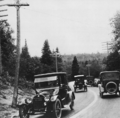Portal:Michigan highways
Michigan Highways
The State Trunkline Highway System of the US state of Michigan is a network of roads owned and maintained by the Michigan Department of Transportation (MDOT). The most prominent of these roads are part of one of three numbered highway systems in Michigan: Interstates Highways, US Highways, and the other State Trunklines. Other systems of roads are operated by the 83 counties in the state as well as each city.


Interstate Highways and US Highways are assigned at the national level. Interstate Highways are numbered in a grid—even-numbered highways are east–west highways (with the lowest numbers along Mexico and the Gulf of Mexico), and odd-numbered highways are north–south highways (with the lowest numbers along the Pacific Ocean). US Highways are also numbered in a grid—even numbered for east–west highways (with the lowest numbers along Canada) and odd numbered for north–south highways (with the lowest numbers along the Atlantic Ocean). For this reason, mainline (two-digit) Interstate Highways in Michigan all have numbers above 69 and mainline US Highways all have numbers below 45. Three-digit Interstate and U.S. Highways, also known as "child routes," are branches off their main one- or two-digit "parents". The Interstate and US Highways are maintained by MDOT. Interstate 75 (I-75) and US Highway 23 (US 23) are the longest examples in the state.


State Trunklines are the other state highways maintained by MDOT. These highways are completely owned and maintained by the state. Michigan highways are properly referred to using the M and never as "Route 28" or "Highway 115", but as M-28 or M-115. The marker used for state trunklines is a diamond with a block-letter "M" at the top. Roads that are maintained by the state but not assigned a state trunkline designation carry an unsigned highway designation.


County-Designated Highways are assigned numbers in a zone system by MDOT, but maintained by the counties. Each zone is indicated by a letter A–H which is followed by a number based on a grid inside that zone. Each county also maintains any other roadway that is not a state trunkline or a city street. The numbering and signing practices vary from county to county, as does the size of each county's system. Numerical designations typically do not carry over from one county to the next; a CDH that crosses county lines keeps its designation in each county however. County road designations are typically abbreviated "CR" or "Co Rd" followed by the number, and CDHs are abbreviated to just their letter and number assignment.
M-553 is a north–south state trunkline highway in the Upper Peninsula (UP) of the US state of Michigan. It connects M-35 near Gwinn with the Marquette Bypass, an expressway carrying US Highway 41 (US 41) and M-28 in Marquette. M-553 connects Marquette with Marquette Sawyer Regional Airport at the unincorporated community of K.I. Sawyer, the former site of a US Air Force base, in the Sands Plains area of Marquette County. The intersection with County Road 480 (CR 480) in Sands Township, known locally as the Crossroads, is the site of several businesses. North of this location, M-553 runs through some hilly terrain around a local ski hill.
The trunkline was originally County Road 553 (CR 553) in Marquette County. CR 553 dates back to the 1930s, was fully paved in the 1940s, and a segment of the roadway was relocated in the 1950s. During the early 1990s, the City of Marquette extended one of their streets, McClellan Avenue, southward to connect to CR 553. The county road was transferred from the Marquette County Road Commission (MCRC) to the jurisdiction of the Michigan Department of Transportation (MDOT) on October 1, 1998. MDOT assigned most of the former county road the M-553 designation after the transfer was complete. One section that was less than a mile (about 1.4 km) was given the M-554 designation. This related trunkline was unsigned by the state with only city street signs to indicate its existence. In 2005, control of various roadways was exchanged between the City of Marquette and MDOT, and M-553 was extended through the city. At the same time, M-554 was turned over to the city's jurisdiction. (Full article...)
General images
Selected picture

Topics
State Trunkline System, overview of the system
- Interstates Highways in the state
- US Highways in the state
- State Trunklines
- County-Designated Highways in the state
- Pure Michigan Byways, a system of scenic, historical or recreational highways in the state
- Great Lakes Circle Tour
Subcategories
Related portals
WikiProjects
Things to do
Nominations and votes for selected articles and selected pictures are always needed. Anyone can nominate an article, and anyone can vote for an article. You can also recommend items for Did you know?. Improvements to the articles are always welcome as the project works on expanding and nominating the remaining ones for Good Article or Featured Article status.





























